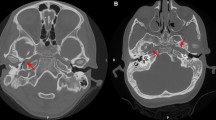Summary
In a study of the growth and dimensions of the Eustachian tube, 47 tubes from 33 foetuses varying in age from the 12th to the 27th menstrual week were removed in toto, stained with PAS, PAS-alcian blue, and the osmium tetroxide whole-mount method. At the beginning of the 12th menstrual week the tube is 2.4 mm in length, at the beginning of the 27th week 12.5 mm. The rate of increase in tubal length is at a maximum from the 20th to the 27th week, amounting to 0.8 mm per week. Later, the weekly increment is presumably only 0.6 mm. The mean inner circumference of the tube is 1.0 mm at the beginning of the 12th week and 4.4 mm at the beginning of the 27th week. The mean diameter of the tube is 0.32 mm at the beginning of the 12th week and 1.38 mm at the beginning of the 27th week. Up to the 15th week the tube is almost round in cross section, but as cartilage develops it becomes first oval and, in the 27th week, slit-shaped.
The development of the tubal cartilage starts towards the end of the 12th week, first in the pharyngeal part of the internal lamina. By the 16th week the newly-formed cartilage attains contact with the tympanic cartilage, and then the development of cartilage starts oin the external lamina. Differentiation of the epithelium and formation of goblet cells in the rhinopharynx starts in the 12th week. Hence, the differentiation spreads towards the tubal orifice, along the tubal floor to the tympanic part and the middle ear.
Zusammzenfassung
Bei Untersuchungen über Wachstum und Dimensionen der Eustachischen Tube wurden 47 Tuben von 33 Foeten der 12.–27. Menstrualwoche in toto herauspräpariert und mit PAS, PAS-alcian-Blau und Osmium Tetroxid in toto gefärbt. Läge und innere Zirkumferenz der Tube wurde gemessen. 12,5 mm lang. Das stäkste Läugenwachstum findet in der 20.–27. Woche statt und beträgt bis zu 0.8 mm wöhentlich. Später beträgt das wöchentliche Wachstum wahrscheinlich our 0,6 mm. Der durchschnittliche innere Umfang der Tube ist am Beginn der 12. Woche 1,0 mm, bei Beginn der 27. Woche 4,4 mm. Der entsprechende mittlere Durchmesser beträgt bei Beginn der 12. Woche 0,32 mm and 1.38 mm am Beginn der 27. Woche. Bis zur 15. Woche ist der Querschnitt der Tube fast rund, aber mit Beginn der Knorpel-Entwicklung wird or oval and in der 27. Woche schlitzfög.
Die Entwicklung des Tubenknorpels beginnt gegen Ende der 12. Woche, zuerst im pharyngealen Teil der inneren Wand. In der 16. Woche bekommt der Tubenknorpel Kontakt mit dem tympanalen Knorpel, und zu dieser Zeit beginnt auch die Entwicklung der Lamina externa. Die Differenzierung des Epithels und die Ausbildung von Becher-Zellen beginnt in der 12. Woche im Rhinopharynx. Von bier breitet sich die Differenzierung zur Tubenmündung und entlang des Bodens zum tympanalen Teil and zum Mittelohr aus.
Similar content being viewed by others
References
Altmann, F.: Entwicklung des Ohres. In: Hals-, Nasen-, Ohren-Heilkunde, Bd. 3/1, S. 10. Ed. J. Berendes, R. Link u. F. Zölner. Stuttgart: Thieme 1965.
Bast, T. H., Anson, B. J.: The temporal bone and ear, p. 306. Springfield, Ill.: Ch. C. Thomas 1949.
Bryant, W. S.: The Eustachian tube. Its anatomy and its movements with a description of the cartilages, muscles, fascia and the fossa Rosenmüler. Med. Rec. 71, 931 (1907).
Buch, N. H., Balslev Jorgensen, M.: Eustachian tube and middle ear. Arch. Otolaryng. 79, 472 (1964).
Eggston, A. A., Wolff, D.: Histopathology of the ear, nose and throat. p. 127. Baltimore: Williams & Wilkins 1947.
Graves, G. O., Edwards, L. F.: The Eustachian tube. Arch. Otolaryng. 39, 359 (1944).
Hammar, J. A.: Studien über die Entwicklung des Vorderdarms und einiger angrenzenden Organe. Arch. mikr. Anat. 59, 471 (1902).
Moe, H.: Mapping goblet cells in mucous membranes. Stain Technol. 27, 141 (1952).
Politzer, A.: Lehrbuch der Ohrenheilkunde, S. 35. Stuttgart: F. Enke 1908.
Symington, J.: The topographical anatomy of the child, p. 50. Edinburgh: Livingstone 1887.
Streeter, G.: Weight, sitting heigt, head size, foot lenght, and menstrual age of the human embryo. Contr. Embryol. Carneg. Inst. 10, 145 (1921).
Tamari, J. M.: Auditory tube and tympanic cavity during embryonal, fetal and prenatal live. Arch. Otolaryng. 57, 627 (1953).
Tos, M.: Development of the tracheal glands in man. Acta path. and microbiol. scand. Suppl. 185, 1 (1966).
— Mucous glands in trachea in children. Quantitative studies. Anat. Anz. 126, 146 (1970a).
— Development of mucous glands in human Eustachian tube. Acta oto-laryng. (Stockh.) 70, 340 (1970b).
Author information
Authors and Affiliations
Rights and permissions
About this article
Cite this article
Tos, M. Growth of the foetal eustachian tube and its dimensions. Arch. Klin. Exp. Ohr.-, Nas.- U. Kehlk. Heilk. 198, 177–186 (1971). https://doi.org/10.1007/BF00312231
Received:
Issue Date:
DOI: https://doi.org/10.1007/BF00312231




